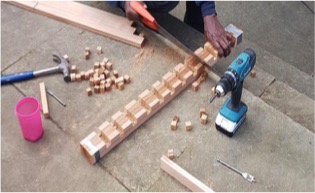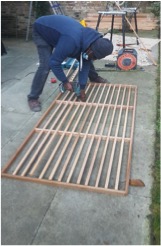Fencing
The VEFEP Fencing Concept
Fences come in a variety of structures and styles. They set boundaries to limit freedom of movement. Our bodies can put up with that, though not without discomfort. But what about our eyes? Most fences imprison our eyes, reducing freedom of movement outside the vicinity of the garden. And if your garden happens to lack size, you may not know what harm your fence is doing to your sight and vision. This problem has been approached in a variety of ways using, (a) (glass), and (b) slatted panels
Let us consider glass. Imagine a huge dining table made of thick wood in a small kitchen. It occupies most of the space and shuts the floor out of sight (Figure 1). Many people do not realize how stressful that table could be until they replace it with a glass table of the same size. The glass table (or slatted panels as shown in Figure 2) occupies the same space. However, whereas the thick wooden table hinders your vision, the glass (or slatted) table frees your eyes to exercise your eye muscles as they travel freely around the kitchen without crashing into the table each time you look at it. To experience this phenomenon, stare at Figure 1, then at Figure 2, and back to Figure 1.
It is known that inhabitants of mountainous regions, whose vision is unrestricted, experience little or no sight problems. The city, on the other hand, has its blessings, but one of the curses is visual stress and associated problems resulting from obstacles in the way of the eye, particularly tall buildings that shut out the sky. Occasionally, we escape, and call it a ‘holiday’. Coming home to your garden, the existence of beautiful flowers do not compensate your eyes for the stress caused by poor fencing. Hence we at London Hands developed the ‘VEFEP’ concept in fencing. In short, we are talking of ‘Visibility Enhancing Fence Panels.’ What are they?
As noted earlier, we do not want to pretend that this concept is new. Many fencing companies use slatted panels. However, most slatted panels are not conceived to enhance visibility. Rather, they are exploited for decorative purposes. Most slatted panels are built that way with the aim to maintain privacy. Do they really attain that goal? No. Those panels, in terms of privacy, are effective only against curious eyes at ground level. Your garden loses its privacy, and yours, to your neighbours on higher floors of their buildings while you imprison your eyes hoping that you are out of sight. Our VEFEP panels are designed to provide as much privacy as other fences do, but without the stress. Here is how we do it.
Privacy
As pointed out above, solid fences provide privacy against only viewers at ground level. For this reason, many gardens have dwarf walls about 1 meter high. In our modern housing arrangement, higher walls or fences do not provide any more privacy around our homes. Rather, they deprive us of visibility without providing any privacy.
Visibility
Higher fences that obstruct view beyond eye level are not doing any good to the eyes. They constitute a source of stress to the eyes as pointed out earlier. To combine privacy and visibility, we recommend a dwarf wall or non-transparent structure at the base, and our visibility enhancing panel above it You cannot see or feel the difference until you experience it (See figures and 2).
More Details
Our panels are produced to specifications (Height, Width, Material (Treated timber or Hard wood). Generally, production and installation take place on site, follows a survey and acceptance of a quote. Our site visit and quote are FREE of charge without any obligations.
Materials
We use different kinds of wood for our panels. Knowing that wood prices differ according to wood density (or durability), our clients are free to choose a specific kind of wood or simply between soft and hard wood. The durability of wood is reflected by its density (weight per cubic size). Below is a list of different wood species. The figures in brackets indicate wood density (grams/cm3) which closely reflects the durability of the wood. There is no specific number for wood density because the same kind of tree, grown in two different geographic environments, may not have the same density. Also, wood density is not uniform throughout a tree, e.g. trunk vs branch. The figures, however, help us see that some kinds of wood are denser (more durable) than others, e.g. Balsa vs Cedar vs teak…
- African Teak (0.98 )
- Cherry (0.70/0.90 )
- Oak (0.85)
- Mahogany (0.71 )
- Balsa (0.11/0.14)
- Pine (0.35/0.85)
- American Walnut (0.64/0.69)
- African Iroko (0.66)
- Western Red Cedar (0.37/0.58)
- European Larch (0.5)
- European Redwood (0.51)
Gallery (Fence For Life)








